- This topic has 12 replies, 6 voices, and was last updated 5 years, 3 months ago by
 Bill Ward.
Bill Ward.
-
AuthorPosts
-
31 August 2018 at 10:16 pm #574118
 Bill WardParticipant
Bill WardParticipantHi All,
With a little practice it becomes quite straightforward to cast ones eye over a meteor spectrum and get a feel for what’s going on.
I’ve now captured many spectra and most have the same basic structure.
Most show some sodium and magnesium along with iron and calcium. There are the occasional Nickel irons with just those lines.
There are the subtle differences discussed elsewhere in the meteor forum but every now and again something unusual appears.
This morning I captured one that did catch my eye as it immediately looked “different”. Took a few seconds to figure out what was missing.
The particular meteor shows absolutely no sodium whatsoever. A very weak signature could be buried in the noise as it wasn’t a particularly bright spectrum but this is the first I’ve seen in a decade where I’ve picked up the other main lines without even a hint of sodium.
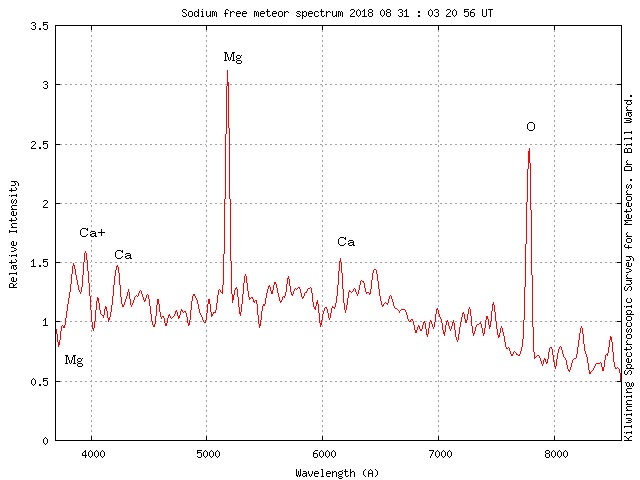
An unusual spectrum to be sure. Conventional thinking is that over time the sodium is depleted from the meteoroid. Thus, if true then this must have been an “old” meteoroid. How old is old?, I have no idea…!
cheers,
Bill.
Attachments:
1 September 2018 at 12:51 am #579945 Eric WatkinsParticipant
Eric WatkinsParticipantHi Bill,
your observation just prompted me to wonder if any ” orbiting space junk” has had it’s spectra captured on a burn up re-entry?
Eric
1 September 2018 at 10:51 am #579946 Alex PrattParticipant
Alex PrattParticipantHi Bill,
My Leeds_N camera recorded a mag 1 Perseid matching the time of your spectrum. I’ve attached the composite image from the video capture and its ground plot. Does this alignment agree with your general azimuth?
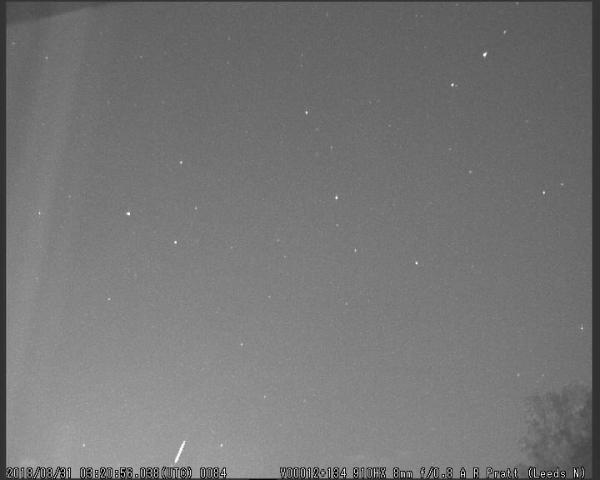
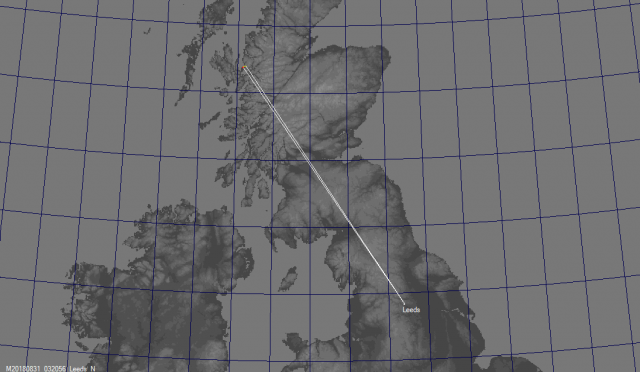
This is a single station result, so if other cameras recorded it we should be able to confirm its shower membership and orbit, etc. I’ll let you know.
Cheers,
Alex.
1 September 2018 at 1:05 pm #579947 William StewartParticipant
William StewartParticipantHi Eric,
Peter Jenniskens is a well known meteor expert, often funded via NASA, and a quick search shows that he has been a co-authored a number of papers related to the spectra of re-entering satellites.
The advantage of satellites is that their trajectory / timing can be defined well in advance which allows the observer to point their camera at the right part of the sky at the right time (and have the grating correctly orientated). Alas meteors are somewhat less predictable.
One of the papers is available here: https://ntrs.nasa.gov/archive/nasa/casi.ntrs.nasa.gov/20160000307.pdf
Best regards
William
1 September 2018 at 3:53 pm #579948 Robin LeadbeaterParticipant
Robin LeadbeaterParticipantI wondered this too. A piece of Mg alloy not large enough to have been tracked but enough to produce a trail ?
Robin
1 September 2018 at 9:19 pm #579949 Bill WardParticipant
Bill WardParticipantHi,
I was hoping you’d catch something with your N facing camera. However even considering the diffration angles involved I don’t think that was the one. I’m on a different machine at the moment but I will double check.
cheers,
Bill.
1 September 2018 at 9:28 pm #579950 Bill WardParticipant
Bill WardParticipantHi,
Regarding space junk, I’m not sure. The fact that the spectrum had a set of the near IR atmospheric lines suggests it was doing a fair clip. All of the re-entry video’s and spectra I’ve seen have been relatively slow (and horrendously complex!) Whilst the most prominent metal lines are certainly Mg and Ca there are weak Fe features which are in the background of most spectra. No guarantee but I’d put my money on it being a tiny bit of something natural.
Cheers,
Bill.
2 September 2018 at 3:36 pm #579954 Bill WardParticipant
Bill WardParticipantHere’s the frame I used to extract the spectrum. The star field can be identified by Dubhe, brightest star lower left. The actual meteor would be ~30/40mm off the edge of the frame on this scale. I hope someone else has it because I’d be surprised if this pans out to be a Perseid, it doesn’t fit the profile…. but you never know!
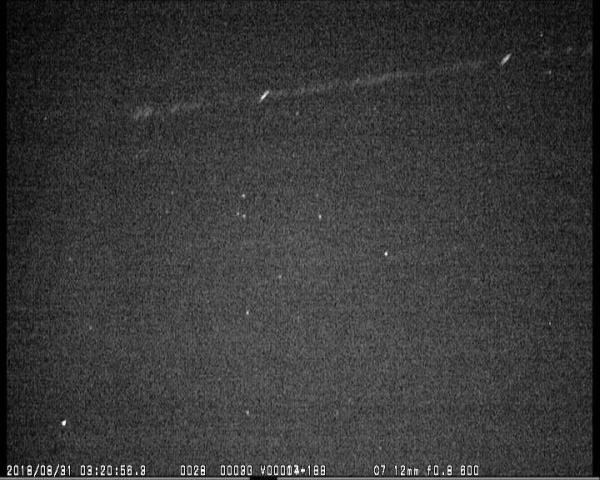 3 September 2018 at 2:19 pm #579958
3 September 2018 at 2:19 pm #579958 Alex PrattParticipant
Alex PrattParticipantHi Bill,
The meteor was also recorded by Andy McCrea (Bangor, NI). He and Michael O’Connell analysed his video clip. My single-station analysis was a good match for a Perseid, but our 2-station result suggests it was a sporadic of absolute mag -2.5 from a radiant in northern Cam with a Vg of 50.6 km/s.


Its short path length of 12 km and our non-optimal viewing geometry only give a Q1-quality solution, so there’s some uncertainty in its computed orbit. I’ll let you know if more data are forthcoming.
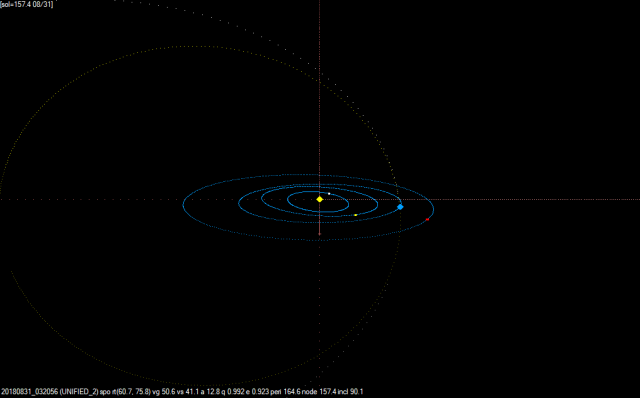
Clear skies,
Alex.
3 September 2018 at 4:18 pm #579959 Bill WardParticipant
Bill WardParticipantHi,
I am relieved, put it down as another success for my comparative meteor spectroscopy method…!
The power of the spectrum!
cheers,
Bill.
3 September 2018 at 7:14 pm #579961 Michael O’ConnellParticipant
Michael O’ConnellParticipantNice work lads, well done!
Regards,
Michael
21 September 2020 at 5:55 pm #583147 Bill WardParticipant
Bill WardParticipantHi all,
Clearly these are relatively rare beasts, I caught only my second sodium free meteor a few nights back…
Very similar in composition to the first in this thread, Ca and Mg are the most prominent lines, interestingly the Ca and Mg lines are from neutral atoms the usually bright Ca+ lines in the near UV and the Mg+ line 448.12nm are missing….
Indirectly it was certainly less than 60km/s but an orbit solution would confirm this.
Did any of the NEMETODE team get this one…?


With recent results it is clear we have quite a zoo of micro geology falling on us!
Cheers,
Bill.
29 September 2020 at 11:42 pm #583192 Bill WardParticipant
Bill WardParticipantYou wait for years then several come along…
Caught another two sodium free meteors last night (early this morning)!
The first was the better, in fact a two for one! Got two meteors in the one frame with Taurus providing a nice background.
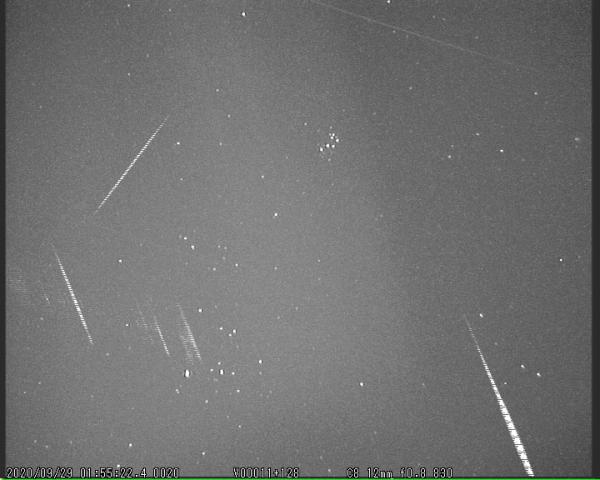
The sodium line should have just peeked into the frame on the far left. Being a touch brighter this spectrum has identifiable Fe lines.The others probably do to but they are just too faint come up in the spectrum. Again the spectrum is dominated by magnesium and calcium.
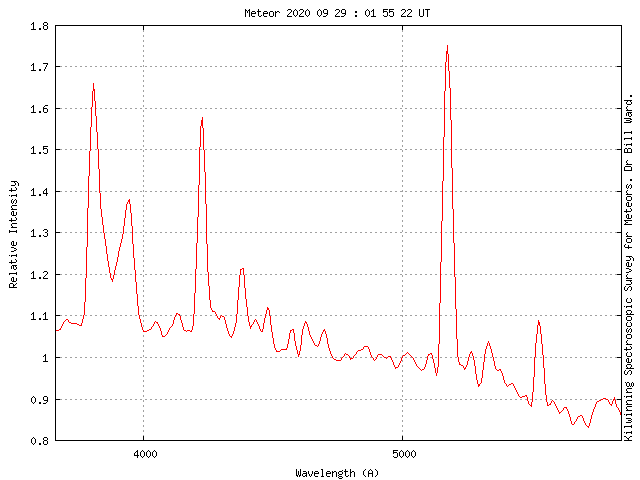
The gents of NEMETODE have a few captures of this one so I’m hoping they can get an orbit!
The other was at 040946 but was faint. Will need a little more work…
The zoo continues to grow!
Cheers,
Bill.
-
AuthorPosts
- You must be logged in to reply to this topic.
